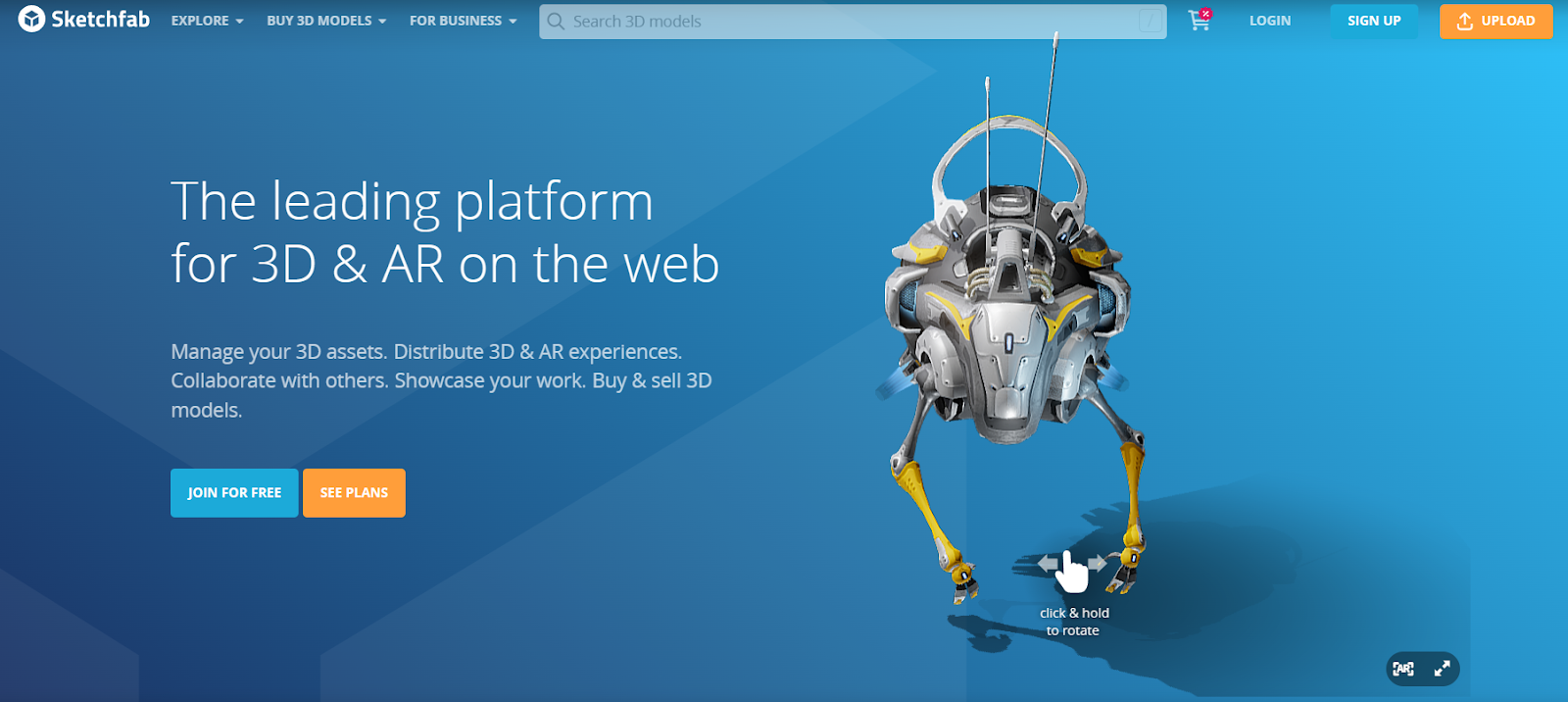Explore the 3D eCommerce World: A Comprehensive Guidebook

Welcome to the exciting world of retail in the digital age! It’s no secret that eCommerce has taken center stage and become an absolute game-changer for the retail industry. In the fast-paced world of online shopping, retailers are always on the lookout for ways to make the experience even more exciting for their customers. And guess what? There’s a cutting-edge technology that’s taking the eCommerce world by storm - 3D eCommerce! Get ready to revolutionize your retail game!
What is 3D E-Commerce?
3D e-commerce, also known as 3D online shopping or 3D retail, is an innovative and immersive approach to conducting online commerce that leverages three-dimensional technology to enhance the shopping experience. Unlike traditional e-commerce platforms that primarily rely on text, images, and two-dimensional representations of products, 3D e-commerce integrates three-dimensional elements, creating a more interactive and engaging shopping environment.
How 3D eCommerce Works?
To understand how 3D eCommerce works, let’s first explore the traditional approach of online product display. Typically, retailers use 2D photos to showcase their products from different angles. While this provides customers with a general idea of what the product looks like, it lacks depth and fails to capture the essence of the item.
3D eCommerce, on the other hand, represents a transformative change in product visualization. It involves the creation of highly detailed and accurate digital 3D models of products. These digital models are crafted to replicate the physical product with precision, capturing every facet of its design, texture, and dimensions.
The key difference lies in the interactivity and realism these 3D models offer. Customers can engage with these models in ways that static images cannot match. They can rotate the product, zoom in for a closer look, and interact with it virtually. This interactivity allows customers to explore the product from every angle, gaining a deeper understanding of its size, shape, materials, and intricate details. It effectively bridges the gap between the online and in-store shopping experiences, providing a more comprehensive and immersive view of the product.
The Benefits of 3D eCommerce
Implementing 3D eCommerce in your online store can bring numerous benefits to both you, as a retailer, and your customers. Let’s take a closer look at some of these advantages.
Enhanced Customer Engagement
One of the primary benefits of 3D eCommerce is the enhanced customer engagement it offers. By allowing customers to interact with 3D models of your products, you provide them with a more immersive and personalized shopping experience. This increased engagement can lead to higher conversion rates and customer satisfaction.
Improved Product Visualization
Unlike 2D photos, 3D models enable customers to view products from every angle, just as they would in a physical store. This enhanced visualization helps customers make better buying choices and reduces the chance that they’ll have to send things back because they didn’t meet their expectations.
Increased Brand Differentiation
Implementing 3D eCommerce sets your online store apart from the competition. By offering a unique and cutting-edge shopping experience, you can elevate your brand and attract customers who appreciate innovation and technology. This differentiation can lead to increased brand loyalty and repeat business.
Reduced Showroom Costs
For businesses, 3D e-commerce can reduce the need for physical showrooms and extensive in-store inventory. Virtual showrooms can showcase the entire product catalog in a digital space, saving on rent, staffing, and maintenance costs.
Compare 2D Photos, 360S, 3D Photos, E-Commerce 3D Models
To fully grasp the potential of 3D eCommerce, it’s essential to compare it with other product visualization methods commonly used by online retailers.
2D Photos
2D photos have been the standard for online product display for years. While they provide a basic representation of the product, they lack depth and fail to offer an immersive shopping experience. Customers can only see the product from a limited number of angles, which may not provide a comprehensive understanding of its features.
360°
360-degree product views offer an improvement over 2D photos by allowing customers to rotate the product image. However, they still fall short in providing a realistic representation of the product. Customers cannot interact with the product or examine it from various perspectives, limiting their ability to assess its true qualities.
3D Photos
3D photos, also known as stereoscopic images, provide a more immersive experience than 2D photos. They create an illusion of depth by presenting two slightly different perspectives of the same image to each eye. However, 3D photos still lack the interactive element that 3D eCommerce brings. Customers cannot manipulate the image, limiting their ability to explore the product fully.
E-Commerce 3D Models
3D eCommerce models offer the most realistic and immersive shopping experience. Customers can rotate, zoom in, and interact with the product, providing a level of engagement that other methods cannot match. This technology truly brings the product to life, allowing customers to examine it from every angle and make more confident purchasing decisions.
The table below summarizes the features of these four types:
| Aspect | 2D Photos | 360° Photos | 3D Photos | E-Commerce 3D Models |
|---|---|---|---|---|
| Dimensionality | 2D images that lack depth and perspective. | Captures a panoramic view, offering a 360-degree look. | Offers three-dimensional depth and perspective. | Presents products in a highly detailed 3D format. |
| Interaction | Limited interaction; static images. | Allows users to pan around an image for exploration. | Users can rotate and zoom to view objects from angles. | Provides an immersive experience with customization. |
| Realism | Limited realism, as it's flat and lacks depth. | Improved realism with a more immersive view. | Enhanced realism due to 3D depth perception. | Offers the highest level of realism and detail. |
| Product Exploration | Limited exploration capability. | Better than 2D photos but still lacks depth. | Offers depth perception, improving exploration. | Provides an immersive and detailed product view. |
| Customization Options | Limited to basic viewing. | Limited customization beyond panoramic view. | Customization options are typically restricted. | Extensive customization, such as colors and sizes. |
| Virtual Try-On | Not possible due to 2D nature. | Not typically used for virtual try-ons. | Limited virtual try-on capabilities. | Often used for virtual try-ons in fashion and more. |
| Use Cases | Commonly used for basic product display. | Ideal for real estate, tourism, and location-based. | Commonly used in art, culture, and design sectors. | Prominent in fashion, home decor, and customization. |
| Enhanced Experience | Does not provide an enhanced shopping experience. | Enhances the viewing experience with 360-degree view. | Improves the shopping experience with depth. | Provides an engaging and immersive shopping experience. |
| Potential for Returns | Higher likelihood of returns due to limited view. | Reduced likelihood of returns as more angles visible. | Reduced likelihood of returns due to depth perception. | Reduced likelihood of returns due to immersive view. |
Examples of Brands Using 3D eCommerce
To gain a better understanding of how 3D eCommerce can be implemented successfully, let’s explore some well-known brands that have embraced this technology.
1. Nike
Nike is a pioneer in adopting 3D eCommerce. Their website allows customers to customize and interact with 3D models of their shoes, giving them a unique and personalized shopping experience. Nike also uses 3D scanning to help customers find the perfect fit for their shoes. Customers can scan their feet at Nike stores or use the Nike Fit app on their phone. Nike then uses this data to recommend shoes that are the right size and fit. This level of engagement has helped Nike stand out from its competitors and build a loyal customer base.

2. IKEA
IKEA, the Swedish furniture giant, has incorporated 3D eCommerce into its online store, allowing customers to explore 3D models of furniture, rotate them, and even place them in virtual room settings to get a better idea of how they would look in their own homes. This is a major improvement over traditional 2D images, which can be difficult to visualize in a real-world setting.
IKEA’s Place app takes this even further by allowing customers to place 3D models of IKEA products in their own homes. This can be extremely helpful for planning out a new space or seeing how a new piece of furniture would look with existing décor. By providing customers with the ability to interact with products in a virtual environment, IKEA is making it easier for them to make informed purchasing decisions.

3. Warby Parker
Warby Parker uses 3D eCommerce to allow customers to virtually try on glasses before they buy them. This is done using augmented reality (AR), which superimposes a digital image of the glasses onto the customer’s face. Customers can use Warby Parker’s AR try-on on their website or app. Just upload a photo of yourself or let the app access your camera to use the feature. The software then shows the customer various Warby Parker glasses. They can also adjust the fit of the glasses and see how they look with different hairstyles and makeup. This innovative approach has revolutionized the eyewear industry, making it easier for customers to find the perfect pair of glasses online.

4. Sephora
Sephora, a well-known cosmetics retailer, has integrated 3D eCommerce into its online store to provide customers with a more engaging and informative shopping experience. Customers can now virtually try on makeup products, view 3D models of products, and learn how to use Sephora products to achieve their desired look.
This use of 3D eCommerce has several benefits for customers. First, virtual try-on allow customers to experiment with different shades and products without having to worry about committing to a purchase. This can be especially helpful for customers who are new to makeup or who are trying out a new look. Second, product visualization gives customers a better sense of how products will look on them before they buy them. This can help customers avoid making impulse purchases that they later regret. Customers are encouraged to experiment with new products and styles, which also helps them get the most out of their purchases.

Getting Started with Internal 3D Modeling
Starting with internal 3D modeling for your business involves several key steps to effectively create and utilize detailed digital representations of interior spaces, products, or structures. Here’s a comprehensive guide:
1. Define Your Goals and Requirements
Determine the specific objectives of your 3D modeling project. Understand the level of detail, realism, and purpose of your model. Consider how you’ll use and share the 3D model within your business.
2. Select the Right Software and Hardware
Choose suitable 3D modeling software based on your project’s requirements. Common options include SketchUp, Blender, Autodesk 3ds Max, Maya, and Revit. Ensure your computer and graphics card meet the software’s system requirements for optimal performance.
3. Learn the Basics of 3D Modeling
Familiarize yourself with the chosen software’s interface, tools, and commands. Gain foundational knowledge in 3D modeling concepts, including geometry, topology, shading, lighting, texturing, and rendering.
4. Create Your 3D Model
Begin by sketching or creating a floor plan of the interior space, product, or structure you want to model. Gradually add details, measurements, materials, colors, and furnishings. You can also utilize pre-existing models or assets from online libraries to expedite the process.
5. Review and Refine Your 3D Model
Thoroughly review your 3D model for errors, discrepancies, or imperfections. Optimize your model for performance, quality, and file size. Use various tools and techniques, such as previews, rendering, exporting, and printing, to ensure your model meets your standards.
6. Share and Showcase Your 3D Model
Choose the appropriate format and platform to present your 3D model to clients, partners, or customers. Utilize images, videos, animations, or interactive applications to effectively convey your design. Consider employing augmented reality (AR), virtual reality (VR), or mixed reality (MR) technologies to immerse your audience in the 3D model experience.
7. Collaborate and Gather Feedback
Collaborate with your team, clients, or stakeholders throughout the 3D modeling process. Encourage feedback and incorporate suggestions to enhance the model’s accuracy and alignment with project goals.
8. Document Your Workflow
Maintain clear documentation of your 3D modeling workflow, including the steps taken, tools used, and any customizations made. This documentation can serve as a valuable reference for future projects.
9. Continuously Improve and Stay Updated
Stay current with advancements in 3D modeling technology and software updates. Continuously improve your skills and techniques to remain competitive in the field.
By following these steps, you can effectively initiate and manage internal 3D modeling projects for your business, whether it involves architectural visualization, product design, marketing materials, or other applications.
Platform and Hosting Solutions Catering to 3D Modeling
To implement 3D eCommerce effectively, you need software and hosting solutions that can support your digital models. Here are some popular options:
1. Software
Sketchfab
Sketchfab is a widely-used platform that allows you to upload, display, and share 3D models. It offers various customization options and embedding capabilities, making it easy to integrate your 3D models into your online store.
Sketchfab has a library of over 100 million 3D models, which includes a wide range of products from different industries. This gives retailers a wide selection of 3D models to choose from to add to their online stores. With Sketchfab’s 3D viewer, customers to view 3D models from multiple angles and perspectives, zoom in and out, and even rotate and interact with them in real time. Moreover, Sketchfab offers easy integration with popular eCommerce platforms such as Shopify, Magento, and WooCommerce. This makes it easy for retailers to add 3D models to their online stores.

Unity
Unity is a powerful game development platform that can also be used as a 3D eCommerce platform. It provides tools and features for creating interactive and immersive experiences, making it ideal for showcasing your products in a dynamic way.
A number of retailers have used Unity to successfully implement 3D eCommerce on their websites. For example, the furniture retailer IKEA has used Unity to create a 3D product configurator that allows customers to customize their furniture before they buy it. The apparel retailer Warby Parker has used Unity to create a virtual try-on experience that allows customers to see how glasses would look on them before they buy them.

2. Hosting
There are some types of hosting solutions catering to 3D modeling for e-commerce businesses:
- Cloud rendering: Cloud rendering services allow you to render your 3D models on remote servers, rather than on your own computer. This can be a good option for businesses that need to render large or complex models, or that need to render models quickly.
- Cloud storage: Cloud storage services allow you to store your 3D models online. This can be a good option for businesses that need to store a large number of models, or that need to access their models from multiple devices or locations.
- Content delivery networks (CDNs): CDNs are distributed networks of servers that deliver content to users based on their location. This can be a good option for businesses that need to deliver their 3D models to customers around the world with high performance and reliability.
- Managed hosting: Managed hosting services provide you with a dedicated server or group of servers that are managed by the hosting provider. This can be a good option for businesses that do not have the time or expertise to manage their own servers.
Some hosting solutions that will be helpful for 3D modeling for your businesses such as: AWS Thinkbox Krakatoa, Google Cloud Platform, Microsoft Azure, or Amazon S3.
Conclusion and Future Trends in 3D eCommerce
As technology continues to advance, the potential of 3D eCommerce is only going to expand. Online retailers who embrace this technology and provide customers with a more immersive and interactive shopping experience are likely to gain a competitive edge in the market. With the right 3D e-commerce platform, hosting solutions, and internal 3D modeling team, you can unlock the full potential of 3D eCommerce for your online store.
In the future, we can expect further advancements in 3D eCommerce, such as augmented reality (AR) and virtual reality (VR) integration. These technologies will further enhance the shopping experience by allowing customers to virtually try on products or explore virtual showrooms. By staying abreast of these trends and implementing them strategically, you can continue to provide your customers with cutting-edge shopping experiences.
So, if you’re an online retailer looking to take your eCommerce game to the next level, it’s time to unlock the potential of 3D eCommerce and provide your customers with a truly immersive and interactive shopping experience.
View what's on trend in 2023
A full checklist to help you prepare for the upcoming year







![Top 20+ Must-have Shopify Apps for 2025 [Free & Paid] - Mageplaza](https://cdn2.mageplaza.com/media/blog/must-have-shopify-apps/top-must-have-shopify-apps.png)
![[2025 Updates] Top 10+ Upsell Apps for Shopify - Mageplaza](https://cdn2.mageplaza.com/media/blog/best-upsell-shopify-app/cover.png)